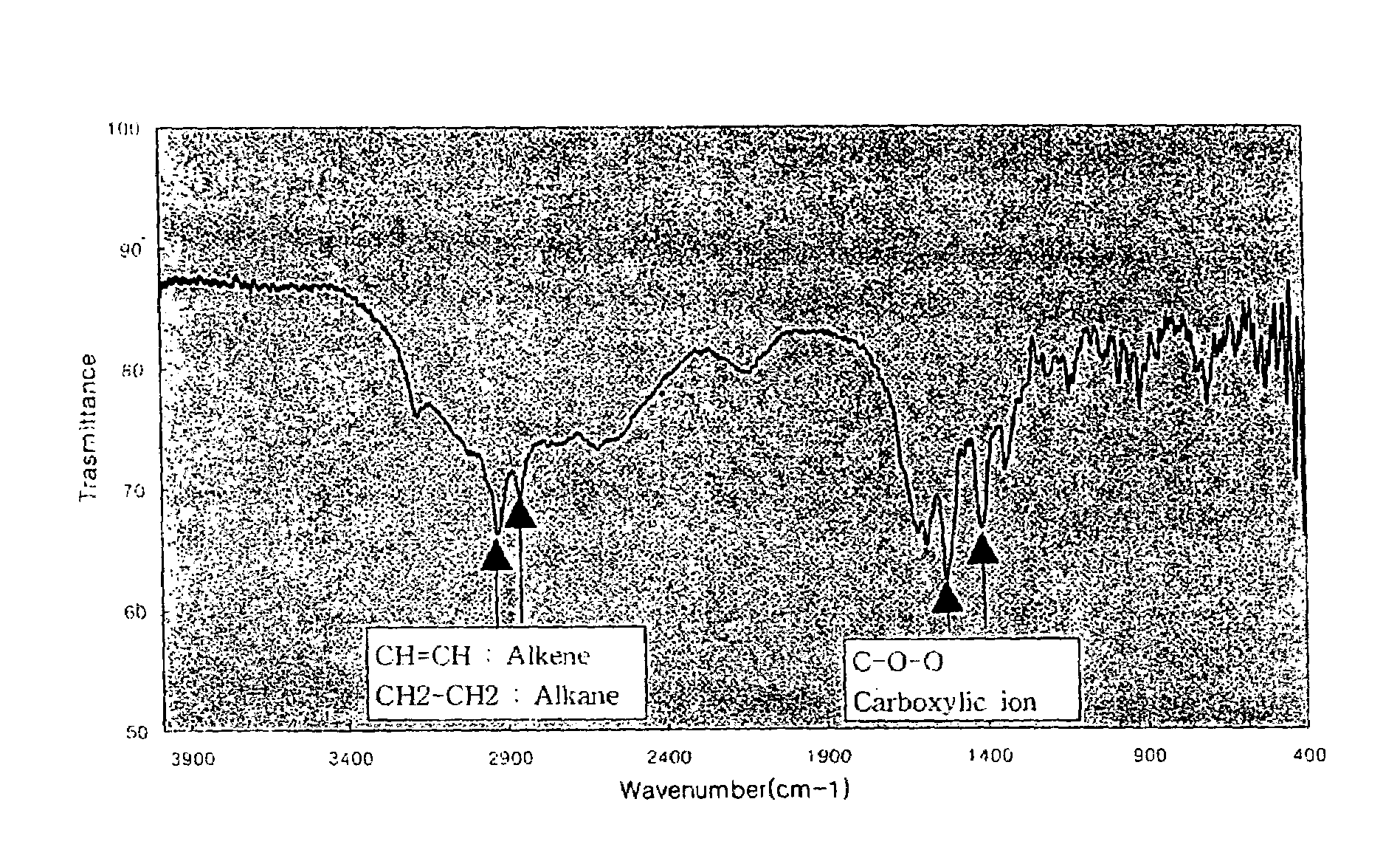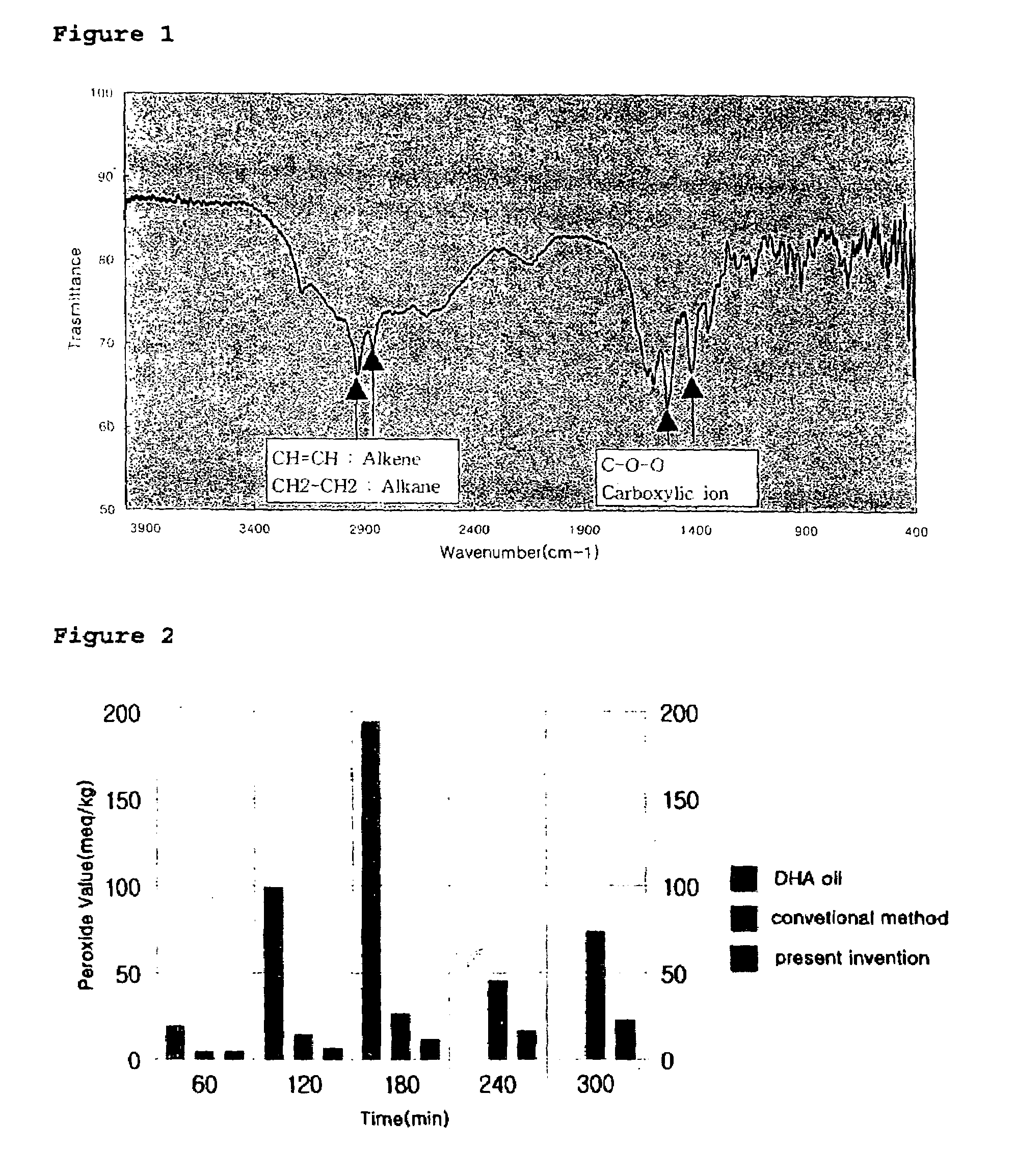Method for improving conversion rate of oil soluble unsaturated lipids into water-soluble lipids
a technology of unsaturated lipids and conversion rate, which is applied in the field of improving the conversion rate of unsaturated lipids into water-soluble lipids, can solve the problems of irritating human body, inability to inject unsaturated lipids directly into the blood, and difficulty in ensuring the safety of human body, so as to achieve excellent stability, improve safety, and attenuate toxicity.
- Summary
- Abstract
- Description
- Claims
- Application Information
AI Technical Summary
Benefits of technology
Problems solved by technology
Method used
Image
Examples
embodiment 1
Method for Preparing Water-Soluble Lipid Complex from Fatty Acids Using Catalysts
[0045]1. Preparation of Conjugated Linoleic Acid-Chloride Derivatives
[0046]After putting 100 g of conjugated linoleic acid (80%) into 50 ml of pyridine to be completely dissolved, 50 ml of thionyl chloride was added by spilt injections to the resulting solution at 4° C. If not adding thionyl chloride by split injections, the reaction proceeds rapidly, thus not avoiding the rancidity of conjugated linoleic acid. Adding thionyl chloride by split injections to the resulting solution to be stirred for about forty minutes resulted in forming crystals. Then, the resulting solution containing such crystals was stationed at room temperature for about two hours and, then, filtered to obtain conjugated linoleic acid-chloride derivatives in the form of crystals.
[0047]2. Preparation of Glycine-Conjugated Linoleic Acid Complexes
[0048]100 g of the conjugated linoleic acid-chloride was put into a solution, in which 1 ...
embodiment 2
Method of Preparing Water-Soluble Lipid Complexes from Fatty Acids Using Catalysts
[0050]1. Preparation of DHA-Chloride Derivatives
[0051]DHA-chloride derivatives were obtained in the form of crystals using DHA instead of the conjugated linoleic acids in the same manner in step 1 of Embodiment 1.
[0052]2. Preparation of Lysine-DHA Complexes
[0053]Lysine was used instead of Glycine in step 2 of Embodiment 1 and, 3 ml, instead of 5 ml, of pyridine and thionyl chloride in the ratio of 1:1 was added to the resulting solution to form DHA-chloride derivatives in the same manner in step 2 of Embodiment 1, thus collecting 139 g of water-soluble complexes.
[0054]The water-soluble complex obtained in the above process was measured using an infrared analyzer and the result is depicted in FIG. 1.
[0055]As shown in FIG. 1, it was found that the carboxylate ion (COO−) peaks of the water-soluble complex are shown at 1560 cm−1 and 1395 cm−1.
embodiment 3
Another Method of Preparing Water-Soluble Lipid Complexes from Fatty Acids Using Emulsifiers
[0056]200 mg of conjugated linoleic acid and 1 L of water were stirred at a stirring rate of 5,000 rpm keeping the temperature 4° C. and, an emulsifier including 2.0 weight % of lecithin, 2.0 weight % of sucrose fatty acid ester and 0.05 weight % of ascorbic acid to a total weight of the solution was added to the resulting solution to be emulsified. Then, mixed powder of 100 g of Glycine and 100 g of lysine was slowly added to the reactant, keeping the reaction conditions of 4° C. and 5,000 rpm till the reactant became a homogenous phase. At the very point of time when the resulting solution became clear, the reaction was terminated. As a result, 393 g of water-soluble complexes were obtained using a lyophilizer.
[0057]The water-soluble complex obtained during the above process was measured using an infrared analyzer and the result is depicted in FIG. 1.
[0058]As shown in FIG. 1, it was found t...
PUM
| Property | Measurement | Unit |
|---|---|---|
| temperature | aaaaa | aaaaa |
| temperature | aaaaa | aaaaa |
| size | aaaaa | aaaaa |
Abstract
Description
Claims
Application Information
 Login to View More
Login to View More - R&D
- Intellectual Property
- Life Sciences
- Materials
- Tech Scout
- Unparalleled Data Quality
- Higher Quality Content
- 60% Fewer Hallucinations
Browse by: Latest US Patents, China's latest patents, Technical Efficacy Thesaurus, Application Domain, Technology Topic, Popular Technical Reports.
© 2025 PatSnap. All rights reserved.Legal|Privacy policy|Modern Slavery Act Transparency Statement|Sitemap|About US| Contact US: help@patsnap.com


